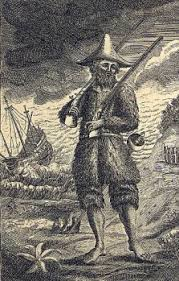The book Robinson Crusoe is one of those classics that is also fun to read. It's the story of a shipwrecked sailor who survived on a deserted island for 28 years. Crusoe had many adventures, including battles with cannibals and mutineers, before his rescue and return to England.
Back in the days of sail there were many shipwrecks and tales of castaways. Daniel Defoe, the author of Robinson Crusoe, would have the accounts of several returnees to base his story on. Most early readers of his book though would have thought immediately of the Scottish sailor Alexander Selkirk, who spent four years on an uninhabited island off the coast of Chile.
Robinson Crusoe's father warns him not to go to sea. On his first voyage from his hometown of York to London his ship runs aground in a storm and he's nearly drowned. On a later trip he's captured by Arabs and enslaved in northern Africa. He manages to escape in a small boat and is taken to Brazil on a Portuguese ship. He starts a plantation in Brazil, but on a trip to Africa for slaves, his ship is wrecked and he alone makes it to the shore of a Caribbean island.
Selkirk was also a rebellious son. Records from 1683 show he was summoned to court for "indecent behavior in church," but he didn't show up. He had gone off to sea. He served on a privateer, a privately owned ship with a license to attack enemy ships. In those days England was almost always at war with someone.
Selkirk rose to be sailing master on his ship. When his ship stopped at the uninhabited island of Más a Tierra 400 miles off the coast Chile to take on water, Selkirk suggested to the captain that they repair the ship before going on. The captain refused and Selkirk said he'd rather stay on the island than continue on such a leaky ship.
The captain took him at his word and left him on the island with a musket, a hatchet, a knife, a Bible, and some bedding and clothes. Selkirk immediately regretted his decision, but the captain said, "Too late." and left him behind. Selkirk's premonitions proved correct. The ship later foundered and the survivors were captured by the Spanish and locked up in Lima.
Selkirk spent his first days on the beach, eating lobsters and hoping for rescue by another ship. When thousands of sea lions arrived on the beach for mating he retreated inland to escape the noise. Here he found a variety of fruits and nuts as well as feral goats which he hunted or kept for milk. He made two huts, one for sleeping, the other for cooking. When rats invaded his huts, he tamed some feral cats to protect him.
He did see two ships land at the island, but they were both Spanish. The crew of the second ship spotted him and gave chase. He ran into the forest which he knew well and lost them. After four years and four months on the island, a British ship landed and took him away. Selkirk was so overjoyed he could barely speak at first. The ship's captain noted Selkirk was in good shape both physically and mentally. The ship was a privateer and Selkirk resumed his buccaneering career, not returning home for another four years.
Back in England he got in trouble again, this time for assaulting a shipwright in Bristol. He may have spent a couple of years in jail. Later he eloped with a dairymaid but they did not marry. During a trip to Plymouth he married a widowed innkeeper. He joined the Royal Navy and on this day in 1721 he succumbed to Yellow Fever while on an anti-piracy patrol off the coast of Africa.
Selkirk never wrote about his experiences, but some of his shipmates did, and there's little doubt the author Defoe would have seen these accounts. The Life and Surprising Adventures of Robinson Crusoe was published two years before Selkirk's burial at sea.
When Robinson Crusoe gets back to England he's tempted to return to the sea, but thinks better of it. He gets married and enjoys the wealth that comes to him from the sale of his Brazilian plantations. The island Selkirk spent four years on has been renamed "Robinson Crusoe." You can travel there and enjoy a goat or lobster dinner, but it still isn't easy to get to.
 |
| "Without my goats, I'd be nothing." |
What a guy! Think if Crusoe had been stranded on the shores of Lake of the Woods in the autumn. "Pretty nice," he might have said. "No bugs, friendly natives, lots of wildlife with tasty flesh, and bunches of trees to build a hut or two." But oh . . . Next comes, you know what. No doubt the following spring the indigenous folks would have found RC's bones, or bones with flesh. Just goes to show who the hearty folks are. Take a bow, Wannaskans!
ReplyDeleteI'm guessing the any indigenous peoples would have been aware of RC's presence pretty quickly after his arrival. They would have given him shelter and food at their casino.
ReplyDeleteThat huge sail ship might've been a giveaway for the Ojibway. They enjoy a good story teller as long as it doesn't involve crooked land dealings, hints of slavery or cultural superiority, limits of religious freedoms, genocide and extended lengths of stay. Visits are okay; residency discouraged.
ReplyDelete